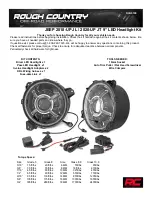
Consumer Information
This has been prepared as re
quired of all manufacturers of
passenger cars under Title 49,
Code of U.S. Federal Regulations,
Part 575 pursuant to the “National
Traffic and Motor Vehicle Safety
Act of 1966”.
Uniform Tire Quality Grading
Refer to the tire sidewall for the
specific tire grades for the tires with
which this vehicle is equipped.
All passenger car tires must con
form to federal safety requirements
in addition to these grades.
Treadwear
The treadwear grade is a com
parative rating based on the wear
rate of the tire when tested under
controlled conditions on a speci
fied government test course. For
example, a tire graded 150 would
wear one and one-half (11/ 2 ) times
as well on the government course
as a tire graded 100. The relative
performance of tires depends upon
the actual conditions of their use,
however, and may depart signifi
cantly from the norm due to varia
tions in driving habits, service
practices and differences in road
characteristics and climate.
Traction “A”, “ B” , “C”
The traction grades, from highest
to lowest, are “A” , “ B” , and “C”,
and they represent the tire’s ability
to stop on wet pavement as meas
ured under controlled conditions on
specified government test surfaces
of asphalt and concrete. A tire
marked “C” may have poor traction
performance.
tested under controlled conditions
on a specified indoor laboratory
test wheel. Sustained high tem pe
rature can cause the material of
the tire to degenerate and reduce
tire life, and excessive temperature
can lead to sudden tire failure. The
grade “C” corresponds to a level of
performance which all passenger
car tires must meet under the
Federal Motor Vehicle Safety
Standard No.109. Grades “B” and
“A ” represent higher levels of
performance on the laboratory test
wheel than the minimum required
by law.
Warning!
The traction grade assigned to
this tire is based on braking
(straight ahead) traction tests
and does not include cornering
(turning) traction.
Temperature “A”, “ B”, “C”
The temperature grades are “A”
(the highest), “B”, and “C” ,
re
presenting
the tire’s resistance to
the generation of heat and its
ability to dissipate heat when
Warning!
The tem perature grade for this
tire is established for a tire that
is properly inflated and not
overloaded. Excessive speed,
underinflation, or excessive
loading, either separately or in
com bination, can cause
excessive heat build up and
possible tire failure.
153
Fue
ls,
C
o
o
la
n
ts
,
L
u
b
ric
a
n
ts
e
tc
.
C
o
ns
um
er
In
fo
rm
a
ti
o
n
Summary of Contents for S 320 1999
Page 1: ......
Page 3: ...Mercedes Benz Owner s Manual S 320 S 420 S 500...
Page 13: ...11 Instruments and Controls...
Page 106: ......
Page 158: ......
Page 159: ...Index...
Page 163: ...NOTES Index...
Page 164: ...NOTES 162...
Page 168: ......
Page 169: ......















































